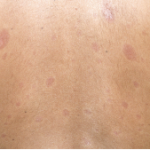Dr. Helfgott is physician editor of The Rheumatologist and associate professor of medicine in the division of rheumatology, immunology, and allergy at Harvard Medical School in Boston.
References
- Cole TB. The cover. JAMA. 2013;309:1562.
- Varga, J. Illness and art: The legacy of Paul Klee. Current Opin Rheumatol. 2004;16:714-717.
- Rodnan GP, Benedek TG. An historical account of the study of progressive systemic sclerosis (diffuse scleroderma). Ann Intern Med. 1962:57;307-319.
- Van den Hoogen F, Khanna D, Fransen J, et al. 2013 classification criteria for systemic sclerosis. Arthritis Rheum. 2013:65;2737-2747.
- Akhmetshina A, Palumbo K, Dees C, Bergmann C. Activation of canonical Wnt signalling is required for TGF-β-mediated fibrosis. Nat Commun. 2012;3:735.
- Kilbourne EM, Riagu-Perez JG, Heath CW, Zack MM. Clinical epidemiology of toxic-oil syndrome. N Engl J Med. 1983;309:1408-1414.
- Epidemiologic notes and reports eosinophilia-myalgia syndrome—New Mexico. MMWR. 1989:38; 765-767.
- Wermuth PJ, Jimenez SA. Gadolinium compounds signaling through TLR4 and TLR7 in normal human macrophages: Establishment of a proinflammatory phenotype and implications for the pathogenesis of nephrogenic systemic fibrosis. J Immunol. 2012; 189:318-327.

